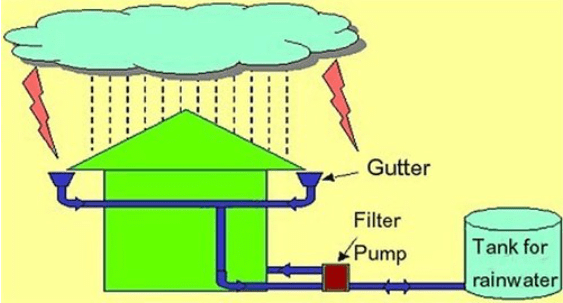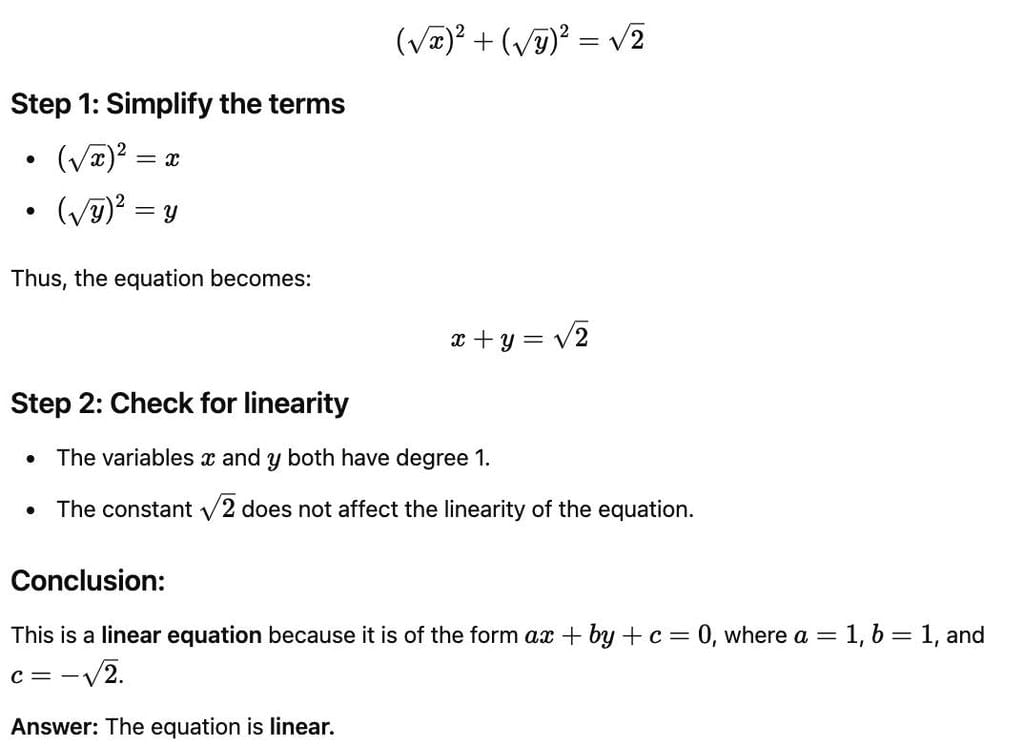All Exams >
EmSAT Achieve >
Mathematics for EmSAT Achieve >
All Questions
All questions of System of Equations for EmSAT Achieve Exam
Which of the following points lies on the line 3x + 2y = 6?- a)(1, 2)
- b)(3, 0)
- c)(2, 3)
- d)(0, 3)
Correct answer is option 'D'. Can you explain this answer?
Which of the following points lies on the line 3x + 2y = 6?
a)
(1, 2)
b)
(3, 0)
c)
(2, 3)
d)
(0, 3)
|
|
Anita Menon answered |
Put the given points in the equation 3x + 2y = 6
If L.H.S of the equation is equal to R.H.S
then the given points will lie on the line
3x + 2y = 6
3.0 + 2.3 = 6
6 =6
L.H.S = R.H.S
So the given point lie on the line.
Which of the following is not the solution of linear equation 
- a)

- b)

- c)

- d)

Correct answer is option 'B'. Can you explain this answer?
Which of the following is not the solution of linear equation 
a)
b)
c)
d)

|
User3820317 answered |
Answer will be a.} 0,√2
because 0+√2=√2
because 0+√2=√2
——————- is the equation of y-axis.- a)y = 1
- b)x = 0
- c)y = -1
- d)y = 0
Correct answer is option 'B'. Can you explain this answer?
——————- is the equation of y-axis.
a)
y = 1
b)
x = 0
c)
y = -1
d)
y = 0

|
Preetam Pyare answered |
Since Every Equation lies on y-axis AtQ.. So, 'x' coordinate of eqn. might be 0 and 'y' Coordinate can be any integer.so,x=0 is the equation of y-axis.Hence,Option(B) is d correct answer..
The force applied on a body is directly proportional to the acceleration produced in the body. Assume x be acceleration produced in the body and y be the force. Take constant as 10.(S.I unit of force is Newton and S.I. unit of acceleration is m/sec2.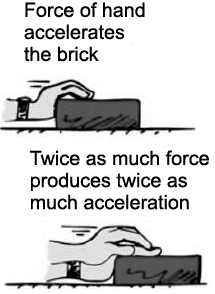 Q. Find acceleration produced in the body, if force applied is 10 newtons.
Q. Find acceleration produced in the body, if force applied is 10 newtons.- a)1 m/sec2
- b)2 m/sec2
- c)3 m/sec2
- d)4 m/sec2
Correct answer is option 'A'. Can you explain this answer?
The force applied on a body is directly proportional to the acceleration produced in the body. Assume x be acceleration produced in the body and y be the force. Take constant as 10.(S.I unit of force is Newton and S.I. unit of acceleration is m/sec2.

Q. Find acceleration produced in the body, if force applied is 10 newtons.
a)
1 m/sec2
b)
2 m/sec2
c)
3 m/sec2
d)
4 m/sec2
|
|
Anita Menon answered |
Given,
Force applied = 10 newtons
c = 10
Since, y = cx
⇒ 10 = 10x
⇒ x = 1
Thus, acceleration produced = 1 m/sec2
A linear equation in one variable is an equation of the form ………..- a)ax + b = 0, where a, b , c are real numbers
- b)ax = c, where a and c are real numbers
- c)by = c, where band c are real number
- d)All of above
Correct answer is option 'D'. Can you explain this answer?
A linear equation in one variable is an equation of the form ………..
a)
ax + b = 0, where a, b , c are real numbers
b)
ax = c, where a and c are real numbers
c)
by = c, where band c are real number
d)
All of above
|
|
Preethi Singh answered |
A linear equation is an equation of a straight line, written in one variable. The only power of the variable is 1. Linear equations in one variable may take the form a x + b = 0, ax+b=0, ax+b=0 and are solved using basic algebraic operations
Temperature is a measure of the warmth or coldness of an object or substance with reference to some standard value.In countries like USA and Canada, temperature is measured in Fahrenheit, whereas in countries like India, it is measured in Celsius.An equation that converts Fahrenheit to Celsius is: On reading the above information, some queries come in Aman’s mind. Help him to resolve his following queries:Answer the following :Q. What is a temperature which is numerically the same in both Fahrenheit and Celsius ?
On reading the above information, some queries come in Aman’s mind. Help him to resolve his following queries:Answer the following :Q. What is a temperature which is numerically the same in both Fahrenheit and Celsius ?- a)40
- b)– 40
- c)30
- d)– 20
Correct answer is option 'B'. Can you explain this answer?
Temperature is a measure of the warmth or coldness of an object or substance with reference to some standard value.
In countries like USA and Canada, temperature is measured in Fahrenheit, whereas in countries like India, it is measured in Celsius.
An equation that converts Fahrenheit to Celsius is:

On reading the above information, some queries come in Aman’s mind. Help him to resolve his following queries:
Answer the following :
Q. What is a temperature which is numerically the same in both Fahrenheit and Celsius ?
a)
40
b)
– 40
c)
30
d)
– 20
|
|
Swati Verma answered |
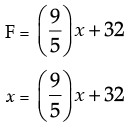
5x = 9x + 160
5x – 9x = 160
– 4x = 160
x = – 40
DIRECTION : In the following questions, a statement of assertion (A) is followed by a statement of reason (R). Mark the correct choice as:Assertion: x + y = 3 is the equation of a line passing through the origin.Reason: y = 2x is the equation of a line passing through the origin.- a)Both assertion (A) and reason (R) are true and reason (R) is the correct explanation of assertion (A).
- b)Both assertion (A) and reason (R) are true but reason (R) is not the correct explanation of assertion (A).
- c)Assertion (A) is true but reason (R) is false.
- d)Assertion (A) is false but reason (R) is true.
Correct answer is option 'D'. Can you explain this answer?
DIRECTION : In the following questions, a statement of assertion (A) is followed by a statement of reason (R). Mark the correct choice as:
Assertion: x + y = 3 is the equation of a line passing through the origin.
Reason: y = 2x is the equation of a line passing through the origin.
a)
Both assertion (A) and reason (R) are true and reason (R) is the correct explanation of assertion (A).
b)
Both assertion (A) and reason (R) are true but reason (R) is not the correct explanation of assertion (A).
c)
Assertion (A) is true but reason (R) is false.
d)
Assertion (A) is false but reason (R) is true.
|
|
Rohit Sharma answered |
For Assertion: The given linear equation is x + y = 3
Since x = 0 and y = 0 is not satisfying x + y = 3, therefore it is not passing through the origin.
So, Assertion is not correct.
Since x = 0 and y = 0 is not satisfying y = 2x, therefore it is passing through the origin.
So, Reason is correct. Correct option is (d) Assertion (A) is false but reason (R) is true.
2x + 4 = 3x + 1 will represent a.- a)Line parallel to X-axis at distance 3 units upwards
- b)Line parallel to X-axis at distance 3 units downwards
- c)Line parallel to Y-axis at distance 3 units left side
- d)Line parallel to Y-axis at distance 3 units on right side
Correct answer is option 'D'. Can you explain this answer?
2x + 4 = 3x + 1 will represent a.
a)
Line parallel to X-axis at distance 3 units upwards
b)
Line parallel to X-axis at distance 3 units downwards
c)
Line parallel to Y-axis at distance 3 units left side
d)
Line parallel to Y-axis at distance 3 units on right side
|
|
Anika Reddy answered |
Solution:
Given equation is 2x - 4 = 3x - 1.
To find the line parallel to the Y-axis at a distance of 3 units on the right side, we need to first solve the given equation for x.
2x - 4 = 3x - 1
Subtracting 2x from both sides, we get
-4 = x - 1
Adding 1 to both sides, we get
-3 = x
Therefore, the value of x is -3.
To find the line parallel to the Y-axis at a distance of 3 units on the right side, we need to draw a vertical line passing through x = -3 and then shift it 3 units to the right.
Hence, the correct option is D - Line parallel to Y-axis at a distance of 3 units on the right side.
HTML Representation:
Solution:
Given equation: 2x - 4 = 3x - 1.
To find the line parallel to the Y-axis at a distance of 3 units on the right side, we need to first solve the given equation for x.
2x - 4 = 3x - 1
Subtracting 2x from both sides, we get
-4 = x - 1
Adding 1 to both sides, we get
-3 = x
Therefore, the value of x is -3.
To find the line parallel to the Y-axis at a distance of 3 units on the right side, we need to draw a vertical line passing through x = -3 and then shift it 3 units to the right.
Hence, the correct option is D - Line parallel to Y-axis at a distance of 3 units on the right side.
Given equation is 2x - 4 = 3x - 1.
To find the line parallel to the Y-axis at a distance of 3 units on the right side, we need to first solve the given equation for x.
2x - 4 = 3x - 1
Subtracting 2x from both sides, we get
-4 = x - 1
Adding 1 to both sides, we get
-3 = x
Therefore, the value of x is -3.
To find the line parallel to the Y-axis at a distance of 3 units on the right side, we need to draw a vertical line passing through x = -3 and then shift it 3 units to the right.
Hence, the correct option is D - Line parallel to Y-axis at a distance of 3 units on the right side.
HTML Representation:
Solution:
Given equation: 2x - 4 = 3x - 1.
To find the line parallel to the Y-axis at a distance of 3 units on the right side, we need to first solve the given equation for x.
2x - 4 = 3x - 1
Subtracting 2x from both sides, we get
-4 = x - 1
Adding 1 to both sides, we get
-3 = x
Therefore, the value of x is -3.
To find the line parallel to the Y-axis at a distance of 3 units on the right side, we need to draw a vertical line passing through x = -3 and then shift it 3 units to the right.
Hence, the correct option is D - Line parallel to Y-axis at a distance of 3 units on the right side.
The cost of a pencil is thrice the cost of rubber.The equivalent linear equation in two variables of above statement is:- a)p = 3 -r
- b)p =1/3 +r
- c)p = 3r
- d)p = 3 + r
Correct answer is option 'C'. Can you explain this answer?
The cost of a pencil is thrice the cost of rubber.The equivalent linear equation in two variables of above statement is:
a)
p = 3 -r
b)
p =1/3 +r
c)
p = 3r
d)
p = 3 + r
|
|
Krithika Sen answered |
Explanation:
Let the cost of rubber be 'r' and the cost of pencil be 'p'.
The given statement states that:
The cost of a pencil is thrice the cost of rubber.
This can be written as:
p = 3r
This is the required linear equation in two variables.
Option Analysis:
a) p = 3 - r
This equation is not equivalent to the given statement. It states that the cost of pencil is equal to 3 minus the cost of rubber, which is not the same as stating that the cost of pencil is thrice the cost of rubber.
b) p = 1/3r
This equation is also not equivalent to the given statement. It states that the cost of pencil is equal to one-third of the cost of rubber, which is not the same as stating that the cost of pencil is thrice the cost of rubber.
c) p = 3r
This equation is the correct equivalent linear equation in two variables of the given statement.
d) p = 3 r
This equation is not equivalent to the given statement. It states that the cost of pencil is equal to 3 and the cost of rubber is equal to 'r', which is not the same as stating that the cost of pencil is thrice the cost of rubber.
Therefore, the correct option is (c) p = 3r.
Let the cost of rubber be 'r' and the cost of pencil be 'p'.
The given statement states that:
The cost of a pencil is thrice the cost of rubber.
This can be written as:
p = 3r
This is the required linear equation in two variables.
Option Analysis:
a) p = 3 - r
This equation is not equivalent to the given statement. It states that the cost of pencil is equal to 3 minus the cost of rubber, which is not the same as stating that the cost of pencil is thrice the cost of rubber.
b) p = 1/3r
This equation is also not equivalent to the given statement. It states that the cost of pencil is equal to one-third of the cost of rubber, which is not the same as stating that the cost of pencil is thrice the cost of rubber.
c) p = 3r
This equation is the correct equivalent linear equation in two variables of the given statement.
d) p = 3 r
This equation is not equivalent to the given statement. It states that the cost of pencil is equal to 3 and the cost of rubber is equal to 'r', which is not the same as stating that the cost of pencil is thrice the cost of rubber.
Therefore, the correct option is (c) p = 3r.
Prime Minister ’s National Relief Fund (also called PMNRF in short) is the fund raised to provide support for people affected by natural and manmade disasters. Natural disasters that are covered under this include flood, cyclone, earthquake etc. Man-made disasters that are included are major accidents, acid attacks, riots, etc. Two friends Sita and Gita, together contributed ₹ 200 towards Prime Minister’s Relief Fund. Answer the following :Q. If both contributed equally, then how much is contributed by each?
Two friends Sita and Gita, together contributed ₹ 200 towards Prime Minister’s Relief Fund. Answer the following :Q. If both contributed equally, then how much is contributed by each?- a)₹ 50, ₹ 150
- b)₹ 100, ₹ 100
- c)₹ 50, ₹ 50
- d)₹ 120, ₹ 120
Correct answer is option 'B'. Can you explain this answer?
Prime Minister ’s National Relief Fund (also called PMNRF in short) is the fund raised to provide support for people affected by natural and manmade disasters. Natural disasters that are covered under this include flood, cyclone, earthquake etc. Man-made disasters that are included are major accidents, acid attacks, riots, etc.

Two friends Sita and Gita, together contributed ₹ 200 towards Prime Minister’s Relief Fund. Answer the following :
Q. If both contributed equally, then how much is contributed by each?
a)
₹ 50, ₹ 150
b)
₹ 100, ₹ 100
c)
₹ 50, ₹ 50
d)
₹ 120, ₹ 120
|
|
Meera Rana answered |
If x = y then x + x = 200
2x = 200

Thus, each contributed is ₹ 100.
Point P(2,-3) lies on the line represented by the equation:- a)x + 2y = 0
- b)x + y = 1
- c)2x + y = 1
- d)2x + 2y = 0
Correct answer is option 'C'. Can you explain this answer?
Point P(2,-3) lies on the line represented by the equation:
a)
x + 2y = 0
b)
x + y = 1
c)
2x + y = 1
d)
2x + 2y = 0
|
|
Shubham Iyer answered |
Solution:
To check which equation represents the line passing through point P(2,-3), we need to substitute the coordinates of P into each equation and see which one satisfies the equation.
Let's check each option one by one:
a) x + 2y = 0
Substituting (2,-3) into this equation:
2 + 2(-3) = -4
The point (2,-3) does not satisfy the equation, so this is not the correct option.
b) x + y = 1
Substituting (2,-3) into this equation:
2 + (-3) = -1
The point (2,-3) does not satisfy the equation, so this is not the correct option.
c) 2x + y = 1
Substituting (2,-3) into this equation:
2(2) + (-3) = 1
The point (2,-3) satisfies the equation, so this is the correct option.
d) 2x + 2y = 0
Substituting (2,-3) into this equation:
2(2) + 2(-3) = -2
The point (2,-3) does not satisfy the equation, so this is not the correct option.
Therefore, the equation that represents the line passing through point P(2,-3) is 2x + y = 1, option C.
To check which equation represents the line passing through point P(2,-3), we need to substitute the coordinates of P into each equation and see which one satisfies the equation.
Let's check each option one by one:
a) x + 2y = 0
Substituting (2,-3) into this equation:
2 + 2(-3) = -4
The point (2,-3) does not satisfy the equation, so this is not the correct option.
b) x + y = 1
Substituting (2,-3) into this equation:
2 + (-3) = -1
The point (2,-3) does not satisfy the equation, so this is not the correct option.
c) 2x + y = 1
Substituting (2,-3) into this equation:
2(2) + (-3) = 1
The point (2,-3) satisfies the equation, so this is the correct option.
d) 2x + 2y = 0
Substituting (2,-3) into this equation:
2(2) + 2(-3) = -2
The point (2,-3) does not satisfy the equation, so this is not the correct option.
Therefore, the equation that represents the line passing through point P(2,-3) is 2x + y = 1, option C.
The number of girls x in a class is 5 less than twice the number of boys y of the same class. The linear equation in two variables for this information is- a)x + 5 = 2y
- b)2x – y = 5
- c)2y – x = -5
- d)x + 2y = -5
Correct answer is option 'A'. Can you explain this answer?
The number of girls x in a class is 5 less than twice the number of boys y of the same class. The linear equation in two variables for this information is
a)
x + 5 = 2y
b)
2x – y = 5
c)
2y – x = -5
d)
x + 2y = -5
|
|
Gautam answered |
The girls are x and boys are y
we will get the equation
x=2y-5 from the given information
which is nothing but
x+5=2y
we will get the equation
x=2y-5 from the given information
which is nothing but
x+5=2y
Which of the following pairs is a solution to the equation 4x + 3y = 10?- a)(1, 2)
- b)(0, 4)
- c)(-1, 6)
- d)(2, 0)
Correct answer is option 'A'. Can you explain this answer?
Which of the following pairs is a solution to the equation 4x + 3y = 10?
a)
(1, 2)
b)
(0, 4)
c)
(-1, 6)
d)
(2, 0)

|
Let's Tute answered |
To find which pair is a solution to the equation 4x + 3y = 10, substitute each pair into the equation:
(1, 2): Substitute to get
This pair works.
4(1)+3(2)
= 4+6
= 10.This pair works.
(0, 4): Substitute to get
This pair does not work.
4(0)+3(4)
= 0+12
= 12.This pair does not work.
(-1, 6): Substitute to get
This pair does not work.
4(-1)+3(6)
= -4+18
= 14.This pair does not work.
(2, 0): Substitute to get
This pair does not work.
4(2)+3(0)
= 8+0
= 8.This pair does not work.
The solution is (1, 2) because it satisfies the equation.
If x=2 and y=1 is a solution of the equation 2x+3y=k, what is the value of k?- a)8
- b)7
- c)6
- d)5
Correct answer is option 'B'. Can you explain this answer?
If x=2 and y=1 is a solution of the equation 2x+3y=k, what is the value of k?
a)
8
b)
7
c)
6
d)
5

|
Let's Tute answered |
Substituting x = 2 and y = 1 into the equation:
2(2) + 3(1) = 4 + 3 = 7, so k = 7.
2(2) + 3(1) = 4 + 3 = 7, so k = 7.
DIRECTION : In the following questions, a statement of assertion (A) is followed by a statement of reason (R). Mark the correct choice as:Assertion : If x = 2k – 1 and y = k is a solution of the equation 3x – 5y – 7 = 0, then the value of k is 10Reason : A linear equation in two variables has infinitely many solutions.- a)Both assertion (A) and reason (R) are true and reason (R) is the correct explanation of assertion (A).
- b)Both assertion (A) and reason (R) are true but reason (R) is not the correct explanation of assertion (A).
- c)Assertion (A) is true but reason (R) is false.
- d)Assertion (A) is false but reason (R) is true.
Correct answer is option 'B'. Can you explain this answer?
DIRECTION : In the following questions, a statement of assertion (A) is followed by a statement of reason (R). Mark the correct choice as:
Assertion : If x = 2k – 1 and y = k is a solution of the equation 3x – 5y – 7 = 0, then the value of k is 10
Reason : A linear equation in two variables has infinitely many solutions.
a)
Both assertion (A) and reason (R) are true and reason (R) is the correct explanation of assertion (A).
b)
Both assertion (A) and reason (R) are true but reason (R) is not the correct explanation of assertion (A).
c)
Assertion (A) is true but reason (R) is false.
d)
Assertion (A) is false but reason (R) is true.
|
|
Swati Verma answered |
We know that a linear equation in two variables has infinitely many solutions. So, Reason is correct.
Since x = 2k -1 and y = k is solution of the given linear equation, we have 3 x (2k -1) -5k -7 = 0 ⇒ 6k -3 -5k -7 = 0 ⇒ k -10 = 0 ⇒ k = 10.
So, Assertion is also correct
But reason (R) is not the correct explanation of assertion (A).
Correct option is (b) Both assertion (A) and reason (R) are true and reason (R) is not the correct explanation of assertion (A).
Which of the following is a solution to the equation x=4?- a)(1, 4)
- b)(2, 3)
- c)(3, 4)
- d)(4, 1)
Correct answer is option 'D'. Can you explain this answer?
Which of the following is a solution to the equation x=4?
a)
(1, 4)
b)
(2, 3)
c)
(3, 4)
d)
(4, 1)
|
|
Madhurima Ahuja answered |
Understanding the Equation x = 4
The equation x = 4 indicates that the value of x is fixed at 4. This means that any point that is a solution to this equation must have its x-coordinate equal to 4.
Evaluating the Options
Let’s analyze each option to determine which one satisfies the equation:
Conclusion
The correct answer is option 'D', (4, 1), because it is the only point among the given options where the x-coordinate matches the value specified in the equation x = 4. Thus, it satisfies the condition set by the equation.
The equation x = 4 indicates that the value of x is fixed at 4. This means that any point that is a solution to this equation must have its x-coordinate equal to 4.
Evaluating the Options
Let’s analyze each option to determine which one satisfies the equation:
- a) (1, 4)
- Here, the x-coordinate is 1.
- Since 1 is not equal to 4, this point is NOT a solution. - b) (2, 3)
- Here, the x-coordinate is 2.
- Since 2 is not equal to 4, this point is NOT a solution. - c) (3, 4)
- Here, the x-coordinate is 3.
- Since 3 is not equal to 4, this point is NOT a solution. - d) (4, 1)
- Here, the x-coordinate is 4.
- Since 4 is equal to 4, this point IS a solution.
Conclusion
The correct answer is option 'D', (4, 1), because it is the only point among the given options where the x-coordinate matches the value specified in the equation x = 4. Thus, it satisfies the condition set by the equation.
The value of k if x = 2, y = 1 is a solution of equation 2x – k = – 3y is- a)7
- b)-7
- c)6
- d)5
Correct answer is option 'A'. Can you explain this answer?
The value of k if x = 2, y = 1 is a solution of equation 2x – k = – 3y is
a)
7
b)
-7
c)
6
d)
5

|
Granger answered |
2*2-k=-3*1(by putting the value of X and y)
4-k=-3
4+3=k
k=7
4-k=-3
4+3=k
k=7
The force applied on a body is directly proportional to the acceleration produced in the body. Assume x be acceleration produced in the body and y be the force. Take constant as 10.(S.I unit of force is Newton and S.I. unit of acceleration is m/sec2.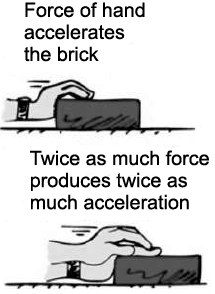 Q. Name the type of equation formed in part(A).
Q. Name the type of equation formed in part(A).- a)Quadratic equation
- b)Cubic equation
- c)Zero equation
- d)Linear equation
Correct answer is option 'D'. Can you explain this answer?
The force applied on a body is directly proportional to the acceleration produced in the body. Assume x be acceleration produced in the body and y be the force. Take constant as 10.(S.I unit of force is Newton and S.I. unit of acceleration is m/sec2.

Q. Name the type of equation formed in part(A).
a)
Quadratic equation
b)
Cubic equation
c)
Zero equation
d)
Linear equation
|
|
Amit Sharma answered |
Y = cx is a linear equation as highest power of x is 1.
Solutions of the equation 2x + 5y = 0 is:- a)3,0
- b)-3,2
- c)0,0
- d)0,4
Correct answer is option 'C'. Can you explain this answer?
Solutions of the equation 2x + 5y = 0 is:
a)
3,0
b)
-3,2
c)
0,0
d)
0,4
|
|
Prateek Kushwaha answered |
Put the value of x and y
if we put
x=0
y=0..
2×0+5×0=0
otherwise
if we try other option so you don't get equal 0
if we put
x=0
y=0..
2×0+5×0=0
otherwise
if we try other option so you don't get equal 0
Difference between the cost of a carpet(C) and a durries(D) is Rs.200. If the carpet is the costlier one of the two, which of the following represents this information?a)C – D = 200b)C – D = 100c)D – C = 200d)C + D = 200Correct answer is option 'A'. Can you explain this answer?

|
Arya Desai answered |
Given,
diff. between the cost of carpet c and durries d is 200,the carpet is costlier
NOW,
c - d = 200
c = 200+d
diff. between the cost of carpet c and durries d is 200,the carpet is costlier
NOW,
c - d = 200
c = 200+d
Which equation represents the relationship where x + 2y = 6 ?- a)x − 2y + 6 = 0
- b)x + 2y − 6= 0
- c)x − 2y − 6 = 0
- d)x + 2y + 6 = 0
Correct answer is option 'B'. Can you explain this answer?
Which equation represents the relationship where x + 2y = 6 ?
a)
x − 2y + 6 = 0
b)
x + 2y − 6= 0
c)
x − 2y − 6 = 0
d)
x + 2y + 6 = 0
|
|
Hridoy Nair answered |
Understanding the Equation
The equation given is x + 2y = 6. This is a linear equation in two variables, x and y. The goal is to rearrange this equation to match the options provided.
Rearranging the Equation
To rewrite the equation in the standard form (Ax + By + C = 0), we can manipulate the original equation:
- Start with x + 2y = 6.
- Subtract 6 from both sides to bring all terms to one side:
x + 2y - 6 = 0.
This matches the standard form Ax + By + C = 0 where A = 1, B = 2, and C = -6.
Matching with Options
Now, let’s compare the rearranged equation with the provided options:
- a) x - 2y + 6 = 0
- b) x + 2y - 6 = 0
- c) x - 2y - 6 = 0
- d) x + 2y + 6 = 0
The rearranged equation x + 2y - 6 = 0 corresponds exactly with option b.
Conclusion
Thus, the correct answer is option 'B': x + 2y - 6 = 0. This form clearly shows the relationship defined by the original equation.
The equation given is x + 2y = 6. This is a linear equation in two variables, x and y. The goal is to rearrange this equation to match the options provided.
Rearranging the Equation
To rewrite the equation in the standard form (Ax + By + C = 0), we can manipulate the original equation:
- Start with x + 2y = 6.
- Subtract 6 from both sides to bring all terms to one side:
x + 2y - 6 = 0.
This matches the standard form Ax + By + C = 0 where A = 1, B = 2, and C = -6.
Matching with Options
Now, let’s compare the rearranged equation with the provided options:
- a) x - 2y + 6 = 0
- b) x + 2y - 6 = 0
- c) x - 2y - 6 = 0
- d) x + 2y + 6 = 0
The rearranged equation x + 2y - 6 = 0 corresponds exactly with option b.
Conclusion
Thus, the correct answer is option 'B': x + 2y - 6 = 0. This form clearly shows the relationship defined by the original equation.
Which of the following pair is a solution of the equation 3x – 2y = 7?- a)(1, -2)
- b)(-2, 1)
- c)(5, 1)
- d)(1, 5)
Correct answer is option 'A'. Can you explain this answer?
Which of the following pair is a solution of the equation 3x – 2y = 7?
a)
(1, -2)
b)
(-2, 1)
c)
(5, 1)
d)
(1, 5)

|
Rhea Dey answered |
Understanding the Equation
To determine which pair is a solution to the equation 3x - 2y = 7, we need to substitute each pair (x, y) into the equation and check if it holds true.
Evaluating the Options
Here are the given pairs:
Substituting Each Pair
1. Option a: (1, -2)
- Substitute x = 1 and y = -2 into the equation:
- 3(1) - 2(-2) = 3 + 4 = 7
- This is correct, so (1, -2) is a solution.
2. Option b: (-2, 1)
- Substitute x = -2 and y = 1:
- 3(-2) - 2(1) = -6 - 2 = -8
- This is not equal to 7, so (-2, 1) is not a solution.
3. Option c: (5, 1)
- Substitute x = 5 and y = 1:
- 3(5) - 2(1) = 15 - 2 = 13
- This is not equal to 7, so (5, 1) is not a solution.
4. Option d: (1, 5)
- Substitute x = 1 and y = 5:
- 3(1) - 2(5) = 3 - 10 = -7
- This is not equal to 7, so (1, 5) is not a solution.
Conclusion
After evaluating all options, the only correct solution is:
Option a: (1, -2)
This confirms that the pair (1, -2) satisfies the equation 3x - 2y = 7.
To determine which pair is a solution to the equation 3x - 2y = 7, we need to substitute each pair (x, y) into the equation and check if it holds true.
Evaluating the Options
Here are the given pairs:
- a) (1, -2)
- b) (-2, 1)
- c) (5, 1)
- d) (1, 5)
Substituting Each Pair
1. Option a: (1, -2)
- Substitute x = 1 and y = -2 into the equation:
- 3(1) - 2(-2) = 3 + 4 = 7
- This is correct, so (1, -2) is a solution.
2. Option b: (-2, 1)
- Substitute x = -2 and y = 1:
- 3(-2) - 2(1) = -6 - 2 = -8
- This is not equal to 7, so (-2, 1) is not a solution.
3. Option c: (5, 1)
- Substitute x = 5 and y = 1:
- 3(5) - 2(1) = 15 - 2 = 13
- This is not equal to 7, so (5, 1) is not a solution.
4. Option d: (1, 5)
- Substitute x = 1 and y = 5:
- 3(1) - 2(5) = 3 - 10 = -7
- This is not equal to 7, so (1, 5) is not a solution.
Conclusion
After evaluating all options, the only correct solution is:
Option a: (1, -2)
This confirms that the pair (1, -2) satisfies the equation 3x - 2y = 7.
Which of the following is a solution to the equation 2x+y=7?- a)(1, 4)
- b)(2, 3)
- c)(3, 2)
- d)(4, 1)
Correct answer is option 'B'. Can you explain this answer?
Which of the following is a solution to the equation 2x+y=7?
a)
(1, 4)
b)
(2, 3)
c)
(3, 2)
d)
(4, 1)

|
Let's Tute answered |
Correct Answer: B - (2,3)
x = 2 and y = 3into the equation:
2(2) + 3 = 4 + 3 = 7, which is true.
Chapter doubts & questions for System of Equations - Mathematics for EmSAT Achieve 2025 is part of EmSAT Achieve exam preparation. The chapters have been prepared according to the EmSAT Achieve exam syllabus. The Chapter doubts & questions, notes, tests & MCQs are made for EmSAT Achieve 2025 Exam. Find important definitions, questions, notes, meanings, examples, exercises, MCQs and online tests here.
Chapter doubts & questions of System of Equations - Mathematics for EmSAT Achieve in English & Hindi are available as part of EmSAT Achieve exam.
Download more important topics, notes, lectures and mock test series for EmSAT Achieve Exam by signing up for free.
Mathematics for EmSAT Achieve
146 videos|222 docs|220 tests
|




